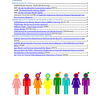SGBV
Sexual and Gender Based Violence
Sexual and gender-based violence[1] (SGBV) remains a serious human rights violation and public health epidemic in all contexts around the world. All forcibly displaced and stateless people—irrespective of age, gender or diversity —are at risk of exposure to SGBV, but displaced women and girls often experience heightened risk.
Sexual and gender-based violence (SGBV) refers to any act that is perpetrated against a person’s will and is based on gender norms and unequal power relationships.
It encompasses threats of violence and coercion. It includes physical, emotional or psychological and sexual violence, and denial of resources or access to services. It inflicts harm on women, girls, men and boys. Forms of SGBV include intimate partner violence, forced marriage, child marriage, and a range of new and emerging forms of violence, such as threats, harassment, stalking, sexual bullying, and abuse that occur on-line or through electronic media and communication technologies amongst others. It comprises violence committed by family and friends, by members of the community, unknown assailants, or that which is perpetrated or condoned by the state, non-state actors, or institutions, or by humanitarian personnel or international peacekeeping forces[2].
The Network focuses on ensuring equitable access to an essential package of quality services is available for survivors of SGBV and victims of trafficking including access to safe spaces and improving response to SGBV disclosure along the displacement route.
Survivor-Centered Approach
Everyone directly or indirectly engaged with survivors must ensure the Guiding Principles to work with SGBV survivors at the individual level, meaning:
- Respect by treating survivors with dignity, ensuring their participation, and respecting their decisions;
- Confidentiality by safeguarding survivors’ right to privacy and maintaining confidentiality;
- Safety by ensuring that the safety of the survivor is of primary concern at all times;
- Non-discrimination by treating everyone based on need alone; and
- Best interests by being a primary consideration in all decisions affecting survivors; the principle is particularly relevant when dealing with children and people with mental disabilities.
Additional Resources
- Call to Action on Protection from Gender-Based Violence in Emergencies webpage, https://www.calltoactiongbv.com/what-we-do
- Girls Not Brides webpage, https://www.girlsnotbrides.org/
- Human Rights Center UC Berkeley School of Law & UNHCR, The Silence I carry: Disclosing gender-based violence in forced displacement, 29 Jan 2019, available at: https://www.refworld.org.es/docid/5c50d7394.html
- IASC, Guideline: The Gender Handbook for Humanitarian Action, February 2018, available at: https://interagencystandingcommittee.org/system/files/2018-iasc_gender_handbook_for_humanitarian_action_eng_0.pdf
- IASC, Guidelines for Integrating Gender-Based Violence Interventions in Humanitarian Action, 2015, available at: https://gbvguidelines.org/en/
- IASC, Interagency Gender-Based Violence Case Management Guidelines, 2017, available at: https://reliefweb.int/sites/reliefweb.int/files/resources/interagency-gbv-case-management-guidelines_final_2017_low-res.pdf
- UN Security Council Resolution 2467 (2019) on Survivor Centered Approach, 23 April 2019, https://undocs.org/S/RES/2467(2019)
- UNHCR, SGBV webpage, https://www.unhcr.org/sexual-and-gender-based-violence.html
- UNHCR, SGBV Prevention, Risk Mitigation and Response, May 2019, available at: https://www.unhcr.org/protection/women/5ce7d6784/sexual-gender-based-violence-prevention-risk-mitigation-response.html
- UNHCR, Action against Sexual and Gender-Based Violence: An Updated Strategy June 2011, available at: http://www.unhcr.org/refworld/docid/4e01ffeb2.html
- UNHCR, Sexual and Gender-based Violence Against Refugees, Returnees and Internally Displaced Persons: Guidelines for Prevention and Response, May 2003, available at: http://www.unhcr.org/refworld/pdfid/3edcd0661.pdf
- UNHCR, Safe from the Start, 2014-2018, https://www.unhcr.org/575a83dd5.html
- UNHCR, Working with Men and Boy Survivors of Sexual and Gender-based Violence in Forced Displacement, July 2012, available at: https://www.refworld.org/docid/5006aa262.html
- UNHCR, UNHCR Policy on Age, Gender, and Diversity Policy, 2018, available at: https://www.unhcr.org/protection/women/5aa13c0c7/policy-age-gender-diversity-accountability-2018.html
- UNICEF & IRC, Caring for Child Survivors of Sexual Abuse: Guidelines for health and psychosocial service providers in humanitarian settings, 2012, First Edition, available at: https://www.refworld.org/docid/532aa6834.html
- WHO, Ethical and Safety Recommendations for Researching, Documenting and Monitoring Sexual Violence in Emergencies, 2007, available at: http://www.who.int/gender/documents/OMS_Ethics&Safety10Aug07.pdf
[1] Although the terms gender-based violence (GBV) and sexual and gender-based violence (SGBV) are often used interchangeably, UNHCR consciously uses the latter to emphasise the urgency of protection interventions that address the criminal character and disruptive consequences of sexual violence for victims/survivors and their families. UNHCR. Action against Sexual and Gender-Based Violence: An Updated Strategy (June 2011). https://cms.emergency.unhcr.org/documents/11982/51689/UNHCR%2C+Action+Against+Sexual+and+Gender-based+Violence.+An+Updated+Strategy%2C+2011/4f9d2a1c-280e-4ac8-a832-1a789de63d46
[1] Referred to as sexual exploitation and abuse (SEA), which entails separate administrative procedures, including mandatory reporting and sanctions. See Secretary-General’s Bulletin. Special measures for protection from sexual exploitation and sexual abuse (ST/SGB/2003/13), 9 Oct 2003.



